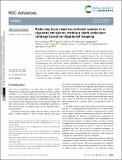Files in this item
Reducing toxic reactive carbonyl species in e-cigarette emissions : testing a harm-reduction strategy based on dicarbonyl trapping
Item metadata
| dc.contributor.author | de Falco, Bruna | |
| dc.contributor.author | Petridis, Antonios | |
| dc.contributor.author | Paramasivan, Poornima | |
| dc.contributor.author | Troise, Antonio Dario | |
| dc.contributor.author | Scaloni, Andrea | |
| dc.contributor.author | Deeni, Yusuf | |
| dc.contributor.author | Stephens, W. Edryd | |
| dc.contributor.author | Fiore, Alberto | |
| dc.date.accessioned | 2020-06-23T09:30:04Z | |
| dc.date.available | 2020-06-23T09:30:04Z | |
| dc.date.issued | 2020-06-05 | |
| dc.identifier | 268642588 | |
| dc.identifier | a8d616b0-077d-4629-a4f2-9d945642ca68 | |
| dc.identifier | 85086519183 | |
| dc.identifier | 000542722900053 | |
| dc.identifier.citation | de Falco , B , Petridis , A , Paramasivan , P , Troise , A D , Scaloni , A , Deeni , Y , Stephens , W E & Fiore , A 2020 , ' Reducing toxic reactive carbonyl species in e-cigarette emissions : testing a harm-reduction strategy based on dicarbonyl trapping ' , RSC Advances , vol. 10 , no. 36 , pp. 21535-21544 . https://doi.org/10.1039/D0RA02138E | en |
| dc.identifier.issn | 2046-2069 | |
| dc.identifier.other | Bibtex: D0RA02138E | |
| dc.identifier.other | ORCID: /0000-0002-0884-8722/work/76386628 | |
| dc.identifier.uri | https://hdl.handle.net/10023/20125 | |
| dc.description | The Carnegie Trust for the Universities of Scotland is thanked for providing funding to support this research (Grant Reference 50408). | en |
| dc.description.abstract | Reducing the concentration of reactive carbonyl species (RCS) in e-cigarette emissions represents a major goal to control their potentially harmful effects. Here, we adopted a novel strategy of trapping carbonyls present in e-cigarette emissions by adding polyphenols in e-liquid formulations. Our work showed that the addition of gallic acid, hydroxytyrosol and epigallocatechin gallate reduced the levels of carbonyls formed in the aerosols of vaped e-cigarettes, including formaldehyde, methylglyoxal and glyoxal. Liquid chromatography mass spectrometry analysis highlighted the formation of covalent adducts between aromatic rings and dicarbonyls in both e-liquids and vaped samples, suggesting that dicarbonyls were formed in the e-liquids as degradation products of propylene glycol and glycerol before vaping. Short-term cytotoxic analysis on two lung cellular models showed that dicarbonyl-polyphenol adducts are not cytotoxic, even though carbonyl trapping did not improve cell viability. Our work sheds lights on the ability of polyphenols to trap RCS in high carbonyl e-cigarette emissions, suggesting their potential value in commercial e-liquid formulations. | |
| dc.format.extent | 10 | |
| dc.format.extent | 958923 | |
| dc.language.iso | eng | |
| dc.relation.ispartof | RSC Advances | en |
| dc.subject | QD Chemistry | en |
| dc.subject | NDAS | en |
| dc.subject.lcc | QD | en |
| dc.title | Reducing toxic reactive carbonyl species in e-cigarette emissions : testing a harm-reduction strategy based on dicarbonyl trapping | en |
| dc.type | Journal article | en |
| dc.contributor.institution | University of St Andrews. School of Earth & Environmental Sciences | en |
| dc.identifier.doi | 10.1039/D0RA02138E | |
| dc.description.status | Peer reviewed | en |
This item appears in the following Collection(s)
Items in the St Andrews Research Repository are protected by copyright, with all rights reserved, unless otherwise indicated.

